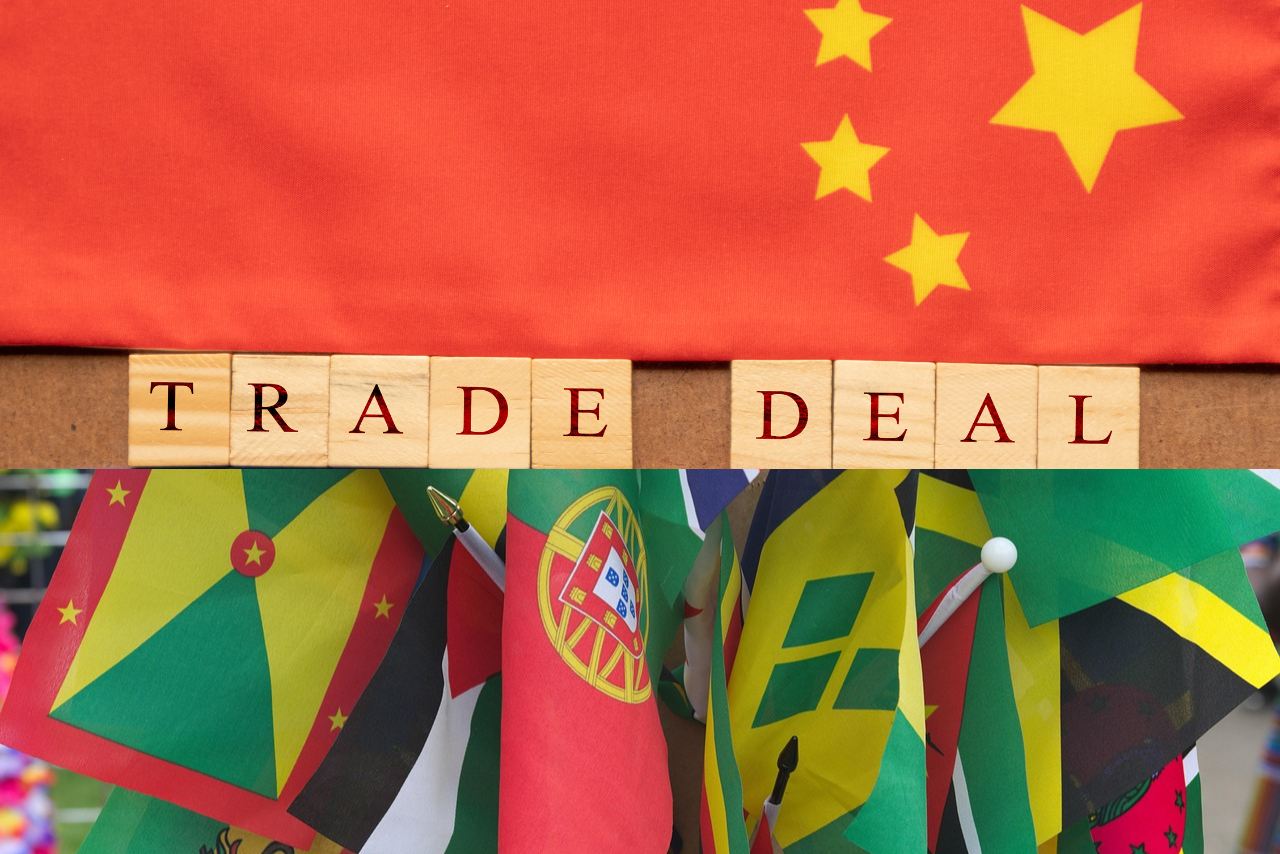
连接中国与加勒比:一位加勒比内部人士对构建贸易与数字通道的见解
Real-life experience
Over three decades working across the Caribbean—advising governments, negotiating CARICOM Treaty revisions, supporting WTO accession and trade promotion via the International Trade Center—experts at Thera Solutions Group (TSG) have seen a persistent challenge: many external players approach Caribbean markets as passive consumers rather than gateways. We noticed this at the CIFIT conference in Xiamen and realized we were often demonstrating the strategic potential of the Caribbean region as a partner for Chinese producers, not just a consumer market.
The Caribbean is more than just a small end-market. It lies between North and South America, underexploited for cross-regional logistics, tourism synergies, and digital commerce. As Chinese firms such as Temu, Alibaba, Baidu, and others explore global expansion, the Caribbean can serve as a strategic node: a physical and digital “Silk Road” extension into Latin America.
This article is a case study of what foreign firms misunderstand, what local actors (governments, chambers, firms) expect, and how a foreign-based but deeply Caribbean-embedded partner can help turn opportunity into execution.
The Caribbean as a Strategic Node, Not Just a Market
1. Trade & geography: the latent value
- In 2023, CARICOM (the Caribbean Community) exported roughly USD 38.8 billion in goods, representing 0.17% of global exports. The Observatory of Economic Complexity
- Yet only a small fraction of that touches China or Asia: historically, CARICOM exports to China were very modest, even when growth was strong in earlier decades (e.g., a 67 % annual growth rate from a low base between 2001–2005). caricom.org
- Meanwhile, Latin America & Caribbean (LAC) as a bloc imports ~$304 billion from China (~20.9 % share), World Integrated Trade Solution.
- The Caribbean’s value is that it can act as a stepping point—with better tariff regimes, connectivity, and local partners—to access neighboring South American markets.
In other words, the Caribbean may never be a “big China-destination” in volume, but its geographic position and policy regimes (9 out of 11 Caribbean countries have diplomatic relations with the PRC, 26 out of 33 for all of LAC) make it a multiplier node.
2. Policy integration and institutional complexity (and opportunity)
For China, the Caribbean now represents a region in transition—economically open, institutionally evolving, and strategically positioned between the Americas, Africa, and Europe. As traditional trade preferences with the United States weaken and Washington, DC adopts a more restrictive tariff policy toward CARICOM exports, Caribbean governments are reassessing their external partnerships. This creates a timely opportunity for China to engage not merely as a financier, but as a long-term development partner helping to modernize institutions, harmonize trade systems, and deepen regional integration. By aligning with the region’s own goals of economic diversification and digital connectivity, China can help shape a more balanced and mutually beneficial relationship in the Western Hemisphere.
- CARICOM’s Revised Treaty of Chaguaramas (2001) embodies the CARICOM Single Market & Economy (CSME), including free movement of skilled persons across member states. Wikipedia+1
- But implementation is uneven; many states lag on full harmonization of trade, investment, and regulatory frameworks. IDB Publications+1
- External agreements (e.g. CARICOM’s negotiation of external trade, capacity building under WTO Trade Facilitation Agreement) are ongoing priorities. caricom.org+1
- Recent U.S. policy shifts (such as the new “Reciprocal Tariff” edict adding 10 % across CARICOM exports) raise external headwinds for Caribbean exporters. Caribbean Trade Law and Development+1
Thus, any foreign firm must appreciate that the “legal/institutional overlay” across 15+ Caribbean jurisdictions is volatile, partially harmonized, and loaded with political sensitivities.
3. Local expectations, credibility & relational capital
From years in-government, inter-governmental, and private-sector circles, we have observed that Caribbean stakeholders do not simply accept foreign actors. Key intangible assets matter:
- Credibility: Did you respect local norms, hire local talent, and deliver high quality on promises?
- Network access: Government contacts, trade associations, chambers, and logistic operators.
- Cultural fluency: Understanding informal norms, procurement culture, and language of trust.
- Adaptability: Recognizing that island economies are vulnerable to climate, disaster, cash flow, and currency stress.
A foreign entrant without those will struggle to scale—or even land pilot projects. That’s what I’ve seen repeatedly.
What Chinese Platforms Misread (Lessons from Failures & Gaps)
Many Chinese firms (Temu, Alibaba, etc.) have global ambitions. Some see the Caribbean simply as another shopfront or port destination. But here are pitfalls they often misjudge:
- Underestimating customs/regulatory friction
Tariff classifications, non-tariff barriers, import licensing, sanitary standards differ even within CARICOM. Delays and fines are common. - Neglecting local logistics & last-mile distribution
Ports may be efficient for bulk entry, but island-to-island freight, warehousing, intra-Caribbean routing is complex. Many small islands lack economies of scale. - Low trust in digital platforms without local branding
Consumers prefer trusted local brands or partnerships; Chinese-only branding can raise concerns of after-sales, returns, warranties. - Misalignment with regional trade strategy
Some Caribbean governments view Chinese deals through a political lens—over-leveraging, debt traps, or sovereignty fears. Missteps can provoke backlash. - Missing tourism-commerce synergy
Caribbean nations rely heavily on tourism. Chinese tourists, supply chains for hotels/resorts, and duty-free shops all matter. A platform that ignores tourism linkages loses value. - Ignoring asymmetric U.S.-Caribbean relations
Given the heavy reliance on U.S. trade and tariffs, shifts in U.S. policy (e.g. new tariffs, “America First”) ripple decisively across the Caribbean. Caribbean Trade Law and Development+3caricom.org+3canadacaribbeaninstitute.org+3
Because of these gaps, many well-resourced entrants stagnate after initial pilot phases.
A Case Study (Hypothetical, but with Realistic Potential)
Note: This is a stylized case, weaving together typical challenges and solutions, not a public client name. This is based on past experience in connecting China with the Caribbean in trade.
Context
A Chinese e-commerce platform (“E-East”) seeks to launch a Latin America-facing cross-border brand via the Caribbean. They plan a regional distribution hub in Guyana, with first touchpoints in Jamaica, Trinidad & Tobago, and the Eastern Caribbean.
Problems encountered early
- Guyana’s port is congested; import licensing delays up to 30 days.
- Jamaica and T&T customs demanded additional documentation for electronics components.
- Local consumers in islands demanded localized warranty/repair and parts service, not just direct shipment.
- In one island, local authorities pressured the company to partner with a politically-connected distributor.
- Competition from existing Chinese importers who had established relationships.
How a well-positioned partner (TSG-style) intervenes
- Regulatory & political navigation
We facilitated introductions with CARICOM Secretariat staff, ministries of trade, and customs agencies. Using prior negotiation of CARICOM Treaty amendments, we advised on tariff carve-outs, customs harmonization, and alignment with WTO TFA timelines. - Local logistics optimization
We structured a bonded warehousing network across key islands, leveraged less-congested secondary ports, and cross-island feeder contracts. Sea and airport infrastructure and procedures improved based on our recommendations. Private sector beneficiaries invested in state-of-the-art operations and digital cargo community systems. We also aggregated smaller volumes to reduce freight costs. - Brand localization & trust building
We helped E-East co-brand with the most successful local retail businesses, set up regional repair centers, and coordinated promotional pilots to test packaging, returns, and local marketing messages. - Government / public diplomacy alignment
Where local governments were wary of foreign dominance, we co-designed CSR (renewable energy, vocational training) initiatives to align the platform’s presence with regional development goals. Based on our recommendations, the government provided lands for further project development. - Tourism-commerce integration
We connected E-East to duty-free operations at airports and cruise ship ports, integrated tourism apps for travelers to receive island e-commerce coupons, and offered hotel-chain logistics promo tie-ins.
Outcomes (after 12 months in this hypothetical model)
- Turnaround time for import-to-delivery cut from 30 to 10 days.
- Penetration in pilot islands reached 5% of target urban households.
- Local warehousing saved ~20% on last-mile cost.
- Government concerns mitigated via joint governance oversight and local hiring.
- The hub in Guyana repositioned to scale not only to the Caribbean but to northern Brazil via air transport.
In sum: by combining local relationships, regulatory insight, logistics engineering, and trust-building, the firm overcame many headwinds that derail average entrants.
Strategic Lessons & Guiding Principles
Below are distilled principles emerging from this Caribbean case lens:
| Principle | Insight |
|---|---|
| Start with the node, not the island | Design for hub-to-spoke scalability, not just local markets. |
| Match regional strategy to national realities | One-size CARICOM strategies must flex to national legal idiosyncrasies. |
| Invest in relational capital early | Government and civil society acceptance is as important as capital. |
| Embed adaptability and local talent | Never treat islands as clones of mainland operations. |
| Leverage tourism and services | Consider local tourism opportunities, airport supply chains, duty-free, hotel procurement. |
| Manage geopolitical perception | Be sensitive to local narratives on sovereignty, debt, and external influence. |
Mandarin Summary / 摘要(中文)
在过去二十多年里,我曾在加勒比地区担任政府顾问、参与 CARICOM 条约谈判、支持世贸组织 WTO 加入,并在国际贸易中心推动该地区的贸易促进。我的经验告诉我,加勒比不仅是消费市场,更是连接拉美的战略枢纽。对于 Temu、阿里巴巴 (Alibaba)、百度 (Baidu) 等企业而言,加勒比具有关键的地理位置、政策潜能与旅游-商务融合的机会。
但是,进入该地区的障碍不少:关税与海关制度复杂、各国分割、物流网络薄弱、本地信任门槛高、政府敏感度强。许多外部平台容易因对当地制度与关系网络理解不足而陷入停滞。
在本文案例中,我展示了一个虚拟但切合实际的跨境电商平台如何在吉亚那设立分拨中心、克服监管、建立本地品牌信任、整合旅游链路,最终向加勒比及南美扩张。成功的关键在于:制度导航、物流设计、本地品牌整合与公共关系协调。
Thera Solutions Group(TSG)虽然总部不在加勒比,但凭借我在该区域的深厚网络、谈判经验与项目执行力,可以作为您进入加勒比—拉美通道的可信伙伴。我们愿为您提供一站式可行性研究、试点执行及扩展方案,助力您把中国与加勒比的“丝绸之路”从理念变为现实。





